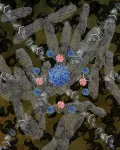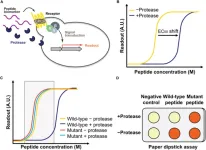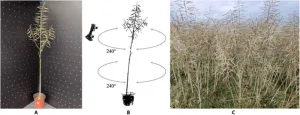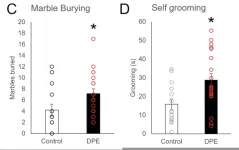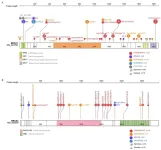(Press-News.org) New research shows that rhythmic brain activity is key to temporarily maintaining important information in memory. Researchers at the Del Monte Institute for Neuroscience at the University of Rochester published these findings today in Current Biology that found brain rhythms—or patterns of neuronal activity—organize the bursts of activity in the brain that maintain short-term connections.
“The thought has been that the temporary storage of important information is linked to neurons in the brain that just fire away, retaining that information until it is no longer needed. Recent research has shown that it might not be such persistent brain activity that matters most for the temporary storage of information, but rather a short-term strengthening of the connections between neurons that are representing the information. Our research shows that brain rhythms are organizing these transient bursts over time,” said Ian Fiebelkorn, PhD, assistant professor of Neuroscience and senior author of the study. “The rhythmic coordination of brain activity over time is important because it allows overlapping populations of neurons to store different pieces of information at the same time.”
Fiebelkorn’s previous research around how the brain processes external information—like when navigating Times Square in New York City—made a similar discovery. He and fellow researchers found that brain rhythms help to coordinate different functions associated with either sampling presently important information or shifting to another source of information. In this context, brain rhythms help to balance focus on the task at hand with being prepared for the unexpected.
In this new research, researchers focused on sampling internally represented (or remembered) information. Using EEG, participants looked at images with vertical or horizontal lines and were asked to remember both the line direction and the location of the image. Researchers found that the strength of the internal representations of these different images alternated over time, on a sub-second timescale, with rhythmic fluctuations in brain activity. Such coordination of brain activity over time allows the role of some neurons to overlap without conflict.
“These rhythmic brain processes might also explain how we can stay focused while multitasking—like when trying to remember an address while driving a car,” Fiebelkorn said. “Rather than simultaneously focusing on these tasks, we might be alternating between them on a sub-second timescale.”
How the brain multitasks is the next step for the Fiebelkorn lab. “What happens when the brain has to do external and internal sampling at the same time, will we see the same sort of rhythmic temporal coordination? That is what we are working to understand next. The more we are able to learn about how these processes typically work helps us understand how these things go awry in neurological disorders.”
Additional authors include Miral Abdalaziz and Zach Redding, PhD, from the Del Monte Institute for Neuroscience at the University of Rochester. This research was supported by the National Science Foundation and the Searle Scholars Program.
END
Researchers find rhythmic brain activity helps to maintain temporary memories
2023-04-25
ELSE PRESS RELEASES FROM THIS DATE:
Near-universal T cell immunity towards a broad range of bacteria
2023-04-25
Typically T cells of the immune system respond to a specific feature (antigen) of a microbe, thereby generating protective immunity. As reported in the journal Immunity, an international team of scientists have discovered an exception to this rule. Namely, a group of divergent bacterial pathogens, including pneumococci, all share a small highly conserved protein sequence, which is both presented and recognized by human T cells in a conserved population-wide manner.
The study set out to understand immune mechanisms that protect against pneumococcus, a bacterial pathobiont that can reside harmlessly in the upper respiratory mucosae but can also cause infectious ...
Novel living yeast-based dual biosensor for detecting peptide variants
2023-04-25
Biosensors—sensors that can detect biological samples—are powerful tools for understanding the function, composition, and structure of biochemical molecules. Biosensors are often applied for the detection of proteins and their subunits, called peptides, yielding a wide range of biomedical applications. In 2017, researchers from Columbia University in USA engineered a living yeast biosensor by rewiring pheromone-related signaling pathways used by yeast for mating. In the presence of the pheromone peptide, the G-protein coupled receptor (GPCR) could detect the peptide, triggering a cascade that would eventually activate a ...
Sizing them up! An algorithm to accurately quantify rapeseed silique morphology
2023-04-25
Rapeseed or oilseed rape (Brassica napus L.) is an important crop cultivated worldwide for its oil-rich seeds. The rapeseed silique is an organ that plays a role in photosynthesis, sends developmental signals to maturing seeds, and provides a capsule that harbors the seeds. High-yield rapeseed varieties have both a high number and optimal morphology–the form and structure–of siliques. In this regard, rapeseed genotype and cultivation method directly influence the number of siliques that a plant produces. Thus, accurately quantifying silique development parameters is critical for predicting ...
Columbia University launches Center for Precision Psychiatry & Mental Health with $75 million grant from the Stavros Niarchos Foundation
2023-04-25
NEW YORK, April 24, 2023—Columbia University today announced the establishment of the Stavros Niarchos Foundation (SNF) Center for Precision Psychiatry & Mental Health at Columbia University. The center will catalyze the scientific innovation and clinical implementation of precision medicine to advance the prevention, diagnosis, and treatment of mental illness. The center is being established with a $75 million grant from the Stavros Niarchos Foundation (SNF), an international philanthropic organization, as part of SNF’s Global Health Initiative (GHI).
The SNF Center is a joint effort of the Department of Psychiatry at Columbia University Vagelos College of Physicians ...
Research links common insecticide to neurodevelopmental disorders
2023-04-25
A new study from The University of Toledo suggests early exposure to a common class of insecticides called pyrethroids may increase the risk of autism and other developmental disorders, even at levels currently recognized as safe by federal regulators.
The findings, which come from a study of mice, were published today in the peer-reviewed journal PNAS Nexus.
Pyrethroids are some of the most widely used insecticides in the country, appearing in both consumer products and industrial preparations.
“If ...
New research sheds light on how to choose quality eHealth tools
2023-04-25
With so many eHealth tools available, it can be challenging to select the best one for a specific health need. A recent study published in JMIR Human Factors provides valuable insights on how to choose quality eHealth tools in an evolving landscape of digital health technology. This study titled “Assessing the Quality and Impact of eHealth Tools: Systematic Literature Review and Narrative Synthesis” comprehensively examined how the quality and impact of eHealth tools are currently assessed.
Led by Dr Christine Jacob, a health tech researcher at the University of Applied Sciences and Arts Northwestern ...
SwRI tests automated vehicles in virtual off-road environments
2023-04-25
SAN ANTONIO – April 25, 2023 – Southwest Research Institute (SwRI) has created a 3D simulation tool to test automated vehicles in virtual off-road environments modeled after real-world conditions. The research expands SwRI’s investment into software-in-the-loop solutions to test connected and automated vehicles (CAVs) in scenarios ranging from congested roadways to off-road terrain. A simulated environment, or a 3D “software loop,” supports evaluations of an infinite number of scenarios that would be cost-prohibitive to test in the real world.
The technology meets U.S. Department of Defense demands ...
Pesticides and neurodevelopment disorders
2023-04-25
A study of 72 mice mothers and their litters suggests a popular pesticide may cause neurodevelopmental disorders in humans. Previous studies have shown that nearly half of the risk for neurodevelopment disorders, including autism, is environmental, but few specific environmental causes have been clearly identified. James Burkett and colleagues exposed mice to low doses of pyrethroid pesticide deltamethrin during pregnancy and lactation. Pups of exposed mothers vocalized less compared to pups of unexposed mothers. ...
HRD detection predicts sensitivity to platinum-based chemotherapy for ovarian cancer patients in China - BGI Insight
2023-04-25
Homologous Recombination Deficiency (HRD) is a biomarker that predicts ovarian cancer treatment with PARP inhibitors or breast cancer treatment with first-line platinum-based chemotherapy. However, limited research is documented on platinum-based treatment prediction with HRD as a biomarker in ovarian cancer patients, especially in the Chinese population.
This first-ever China prospective cohort study, jointly conducted by BGI Genomics clinical researcher Dr. Shao Di and the Fudan University Shanghai Cancer Center team and published on the Journal of Ovarian ...
NIAID appoints Ted Pierson as new Vaccine Research Center director
2023-04-25
“Ted brings a wealth of knowledge and expertise in virology and human immune responses to viruses. He has played a key role in developing antiviral vaccines and furthering our understanding of important viruses transmitted by mosquitoes and ticks—arboviruses—and how neutralizing antibodies work against flaviviruses, such as Zika virus,” said Acting NIAID Director Hugh Auchincloss, M.D. “He is exceptionally well-suited to lead the VRC and its continued pursuit of innovative basic, translational and clinical discovery.”
Prior to his VRC appointment, Dr. Pierson served as a senior investigator and chief of NIAID’s Laboratory of ...
